Business Models and Organizational Changes: Strategies and Impacts
VerifiedAdded on 2020/03/01
|7
|2173
|419
Essay
AI Summary
This essay examines the construction and evolution of business models, emphasizing the importance of adaptability and strategic planning in response to organizational changes and market dynamics. It explores the need for managers to anticipate market trends and equip employees to address challenges, using Cadbury's response to the recession as an example of proactive opportunity creation. The essay details the structure and function of business models, including e-business archetypes, activity systems, and cost-revenue architecture. It distinguishes between static and dynamic problems, highlighting the importance of pre-preparation and flexibility. The discussion extends to the business context, encompassing micro and macro environments, and underscores the inevitability of change and its potential to drive success. The essay concludes by emphasizing the role of business model flexibility, employee training, and management preparedness in navigating both predictable and unpredictable changes, offering a comprehensive perspective on business model design and organizational resilience.
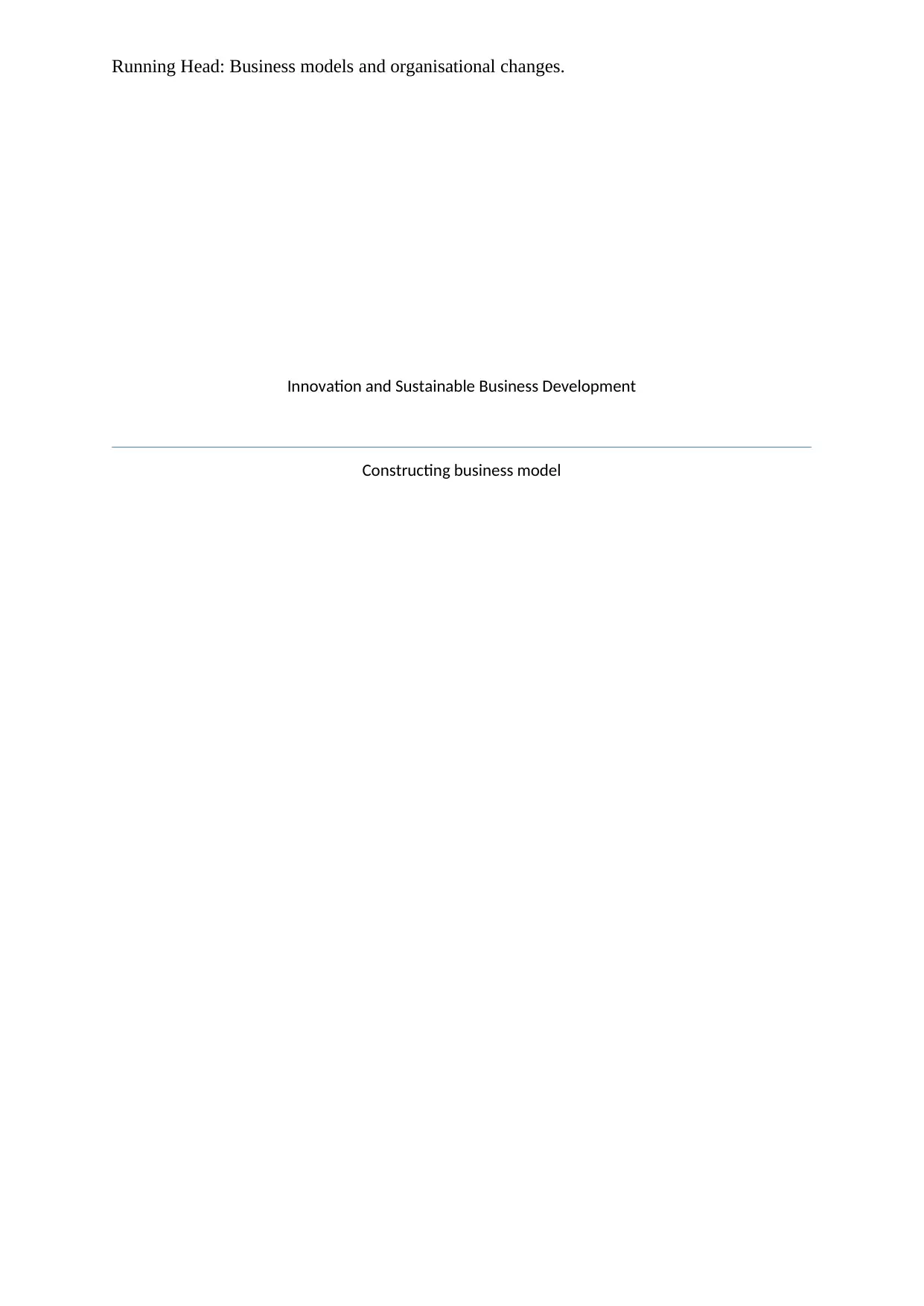
Running Head: Business models and organisational changes.
Innovation and Sustainable Business Development
Constructing business model
Innovation and Sustainable Business Development
Constructing business model
Paraphrase This Document
Need a fresh take? Get an instant paraphrase of this document with our AI Paraphraser
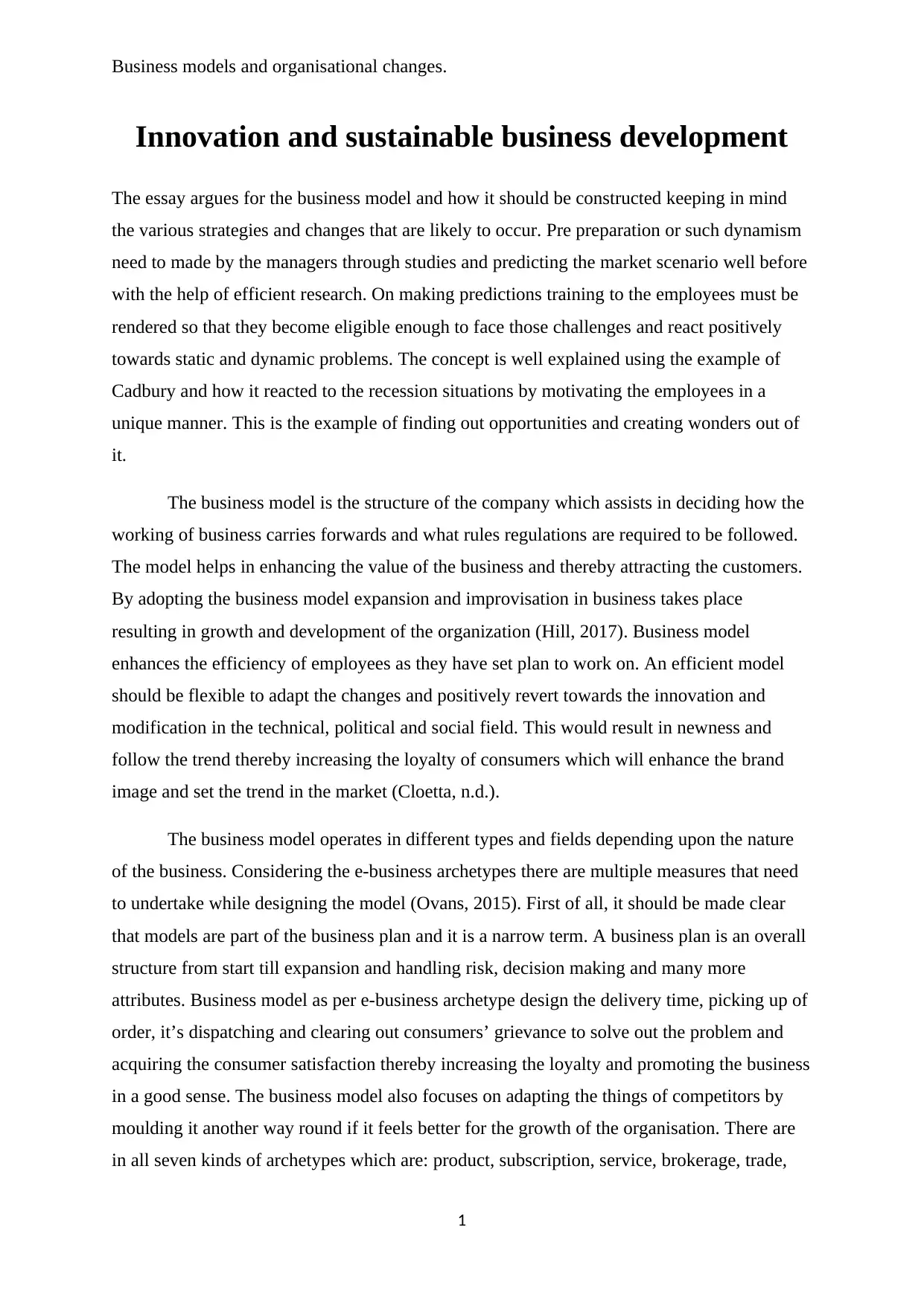
Business models and organisational changes.
Innovation and sustainable business development
The essay argues for the business model and how it should be constructed keeping in mind
the various strategies and changes that are likely to occur. Pre preparation or such dynamism
need to made by the managers through studies and predicting the market scenario well before
with the help of efficient research. On making predictions training to the employees must be
rendered so that they become eligible enough to face those challenges and react positively
towards static and dynamic problems. The concept is well explained using the example of
Cadbury and how it reacted to the recession situations by motivating the employees in a
unique manner. This is the example of finding out opportunities and creating wonders out of
it.
The business model is the structure of the company which assists in deciding how the
working of business carries forwards and what rules regulations are required to be followed.
The model helps in enhancing the value of the business and thereby attracting the customers.
By adopting the business model expansion and improvisation in business takes place
resulting in growth and development of the organization (Hill, 2017). Business model
enhances the efficiency of employees as they have set plan to work on. An efficient model
should be flexible to adapt the changes and positively revert towards the innovation and
modification in the technical, political and social field. This would result in newness and
follow the trend thereby increasing the loyalty of consumers which will enhance the brand
image and set the trend in the market (Cloetta, n.d.).
The business model operates in different types and fields depending upon the nature
of the business. Considering the e-business archetypes there are multiple measures that need
to undertake while designing the model (Ovans, 2015). First of all, it should be made clear
that models are part of the business plan and it is a narrow term. A business plan is an overall
structure from start till expansion and handling risk, decision making and many more
attributes. Business model as per e-business archetype design the delivery time, picking up of
order, it’s dispatching and clearing out consumers’ grievance to solve out the problem and
acquiring the consumer satisfaction thereby increasing the loyalty and promoting the business
in a good sense. The business model also focuses on adapting the things of competitors by
moulding it another way round if it feels better for the growth of the organisation. There are
in all seven kinds of archetypes which are: product, subscription, service, brokerage, trade,
1
Innovation and sustainable business development
The essay argues for the business model and how it should be constructed keeping in mind
the various strategies and changes that are likely to occur. Pre preparation or such dynamism
need to made by the managers through studies and predicting the market scenario well before
with the help of efficient research. On making predictions training to the employees must be
rendered so that they become eligible enough to face those challenges and react positively
towards static and dynamic problems. The concept is well explained using the example of
Cadbury and how it reacted to the recession situations by motivating the employees in a
unique manner. This is the example of finding out opportunities and creating wonders out of
it.
The business model is the structure of the company which assists in deciding how the
working of business carries forwards and what rules regulations are required to be followed.
The model helps in enhancing the value of the business and thereby attracting the customers.
By adopting the business model expansion and improvisation in business takes place
resulting in growth and development of the organization (Hill, 2017). Business model
enhances the efficiency of employees as they have set plan to work on. An efficient model
should be flexible to adapt the changes and positively revert towards the innovation and
modification in the technical, political and social field. This would result in newness and
follow the trend thereby increasing the loyalty of consumers which will enhance the brand
image and set the trend in the market (Cloetta, n.d.).
The business model operates in different types and fields depending upon the nature
of the business. Considering the e-business archetypes there are multiple measures that need
to undertake while designing the model (Ovans, 2015). First of all, it should be made clear
that models are part of the business plan and it is a narrow term. A business plan is an overall
structure from start till expansion and handling risk, decision making and many more
attributes. Business model as per e-business archetype design the delivery time, picking up of
order, it’s dispatching and clearing out consumers’ grievance to solve out the problem and
acquiring the consumer satisfaction thereby increasing the loyalty and promoting the business
in a good sense. The business model also focuses on adapting the things of competitors by
moulding it another way round if it feels better for the growth of the organisation. There are
in all seven kinds of archetypes which are: product, subscription, service, brokerage, trade,
1
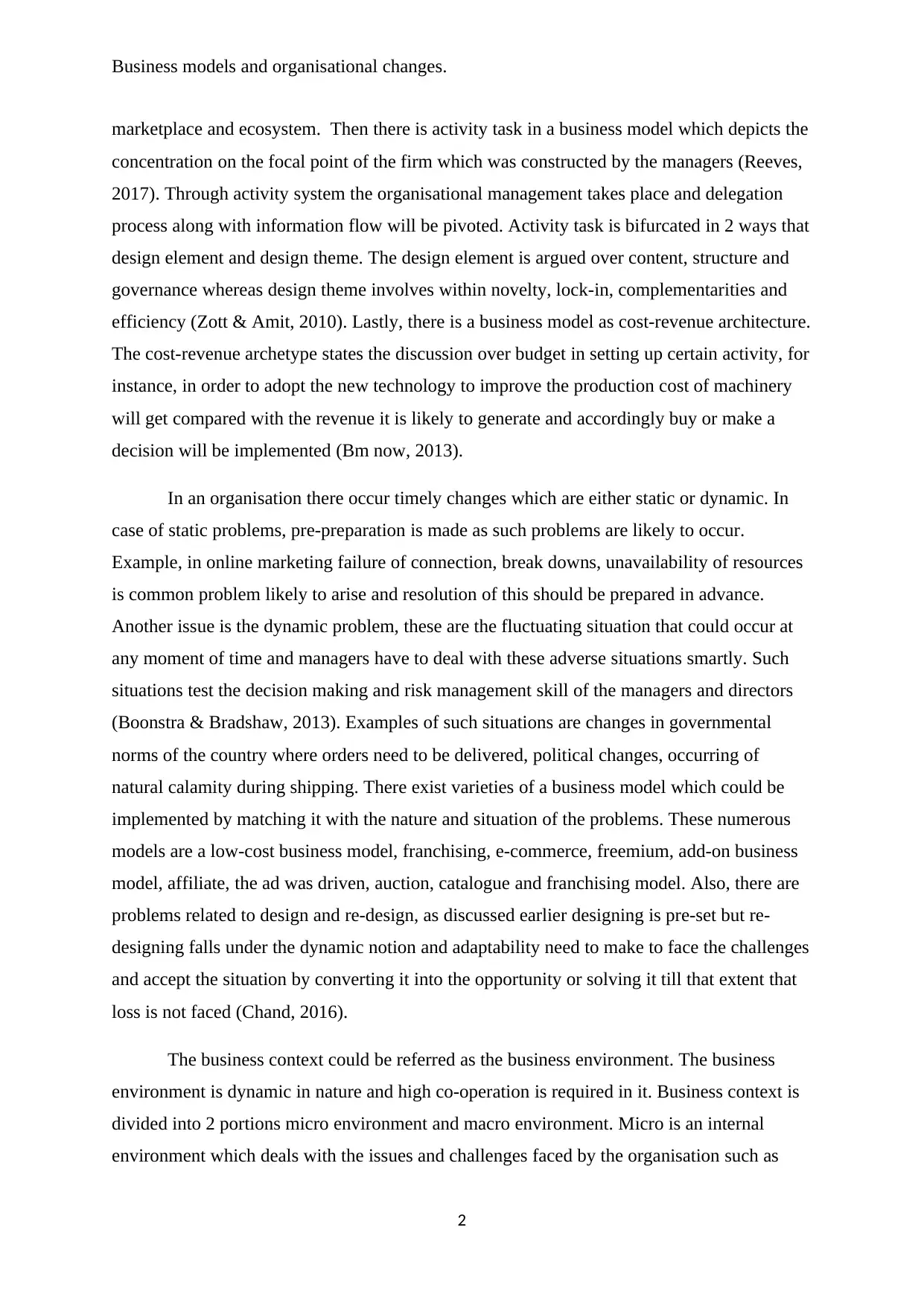
Business models and organisational changes.
marketplace and ecosystem. Then there is activity task in a business model which depicts the
concentration on the focal point of the firm which was constructed by the managers (Reeves,
2017). Through activity system the organisational management takes place and delegation
process along with information flow will be pivoted. Activity task is bifurcated in 2 ways that
design element and design theme. The design element is argued over content, structure and
governance whereas design theme involves within novelty, lock-in, complementarities and
efficiency (Zott & Amit, 2010). Lastly, there is a business model as cost-revenue architecture.
The cost-revenue archetype states the discussion over budget in setting up certain activity, for
instance, in order to adopt the new technology to improve the production cost of machinery
will get compared with the revenue it is likely to generate and accordingly buy or make a
decision will be implemented (Bm now, 2013).
In an organisation there occur timely changes which are either static or dynamic. In
case of static problems, pre-preparation is made as such problems are likely to occur.
Example, in online marketing failure of connection, break downs, unavailability of resources
is common problem likely to arise and resolution of this should be prepared in advance.
Another issue is the dynamic problem, these are the fluctuating situation that could occur at
any moment of time and managers have to deal with these adverse situations smartly. Such
situations test the decision making and risk management skill of the managers and directors
(Boonstra & Bradshaw, 2013). Examples of such situations are changes in governmental
norms of the country where orders need to be delivered, political changes, occurring of
natural calamity during shipping. There exist varieties of a business model which could be
implemented by matching it with the nature and situation of the problems. These numerous
models are a low-cost business model, franchising, e-commerce, freemium, add-on business
model, affiliate, the ad was driven, auction, catalogue and franchising model. Also, there are
problems related to design and re-design, as discussed earlier designing is pre-set but re-
designing falls under the dynamic notion and adaptability need to make to face the challenges
and accept the situation by converting it into the opportunity or solving it till that extent that
loss is not faced (Chand, 2016).
The business context could be referred as the business environment. The business
environment is dynamic in nature and high co-operation is required in it. Business context is
divided into 2 portions micro environment and macro environment. Micro is an internal
environment which deals with the issues and challenges faced by the organisation such as
2
marketplace and ecosystem. Then there is activity task in a business model which depicts the
concentration on the focal point of the firm which was constructed by the managers (Reeves,
2017). Through activity system the organisational management takes place and delegation
process along with information flow will be pivoted. Activity task is bifurcated in 2 ways that
design element and design theme. The design element is argued over content, structure and
governance whereas design theme involves within novelty, lock-in, complementarities and
efficiency (Zott & Amit, 2010). Lastly, there is a business model as cost-revenue architecture.
The cost-revenue archetype states the discussion over budget in setting up certain activity, for
instance, in order to adopt the new technology to improve the production cost of machinery
will get compared with the revenue it is likely to generate and accordingly buy or make a
decision will be implemented (Bm now, 2013).
In an organisation there occur timely changes which are either static or dynamic. In
case of static problems, pre-preparation is made as such problems are likely to occur.
Example, in online marketing failure of connection, break downs, unavailability of resources
is common problem likely to arise and resolution of this should be prepared in advance.
Another issue is the dynamic problem, these are the fluctuating situation that could occur at
any moment of time and managers have to deal with these adverse situations smartly. Such
situations test the decision making and risk management skill of the managers and directors
(Boonstra & Bradshaw, 2013). Examples of such situations are changes in governmental
norms of the country where orders need to be delivered, political changes, occurring of
natural calamity during shipping. There exist varieties of a business model which could be
implemented by matching it with the nature and situation of the problems. These numerous
models are a low-cost business model, franchising, e-commerce, freemium, add-on business
model, affiliate, the ad was driven, auction, catalogue and franchising model. Also, there are
problems related to design and re-design, as discussed earlier designing is pre-set but re-
designing falls under the dynamic notion and adaptability need to make to face the challenges
and accept the situation by converting it into the opportunity or solving it till that extent that
loss is not faced (Chand, 2016).
The business context could be referred as the business environment. The business
environment is dynamic in nature and high co-operation is required in it. Business context is
divided into 2 portions micro environment and macro environment. Micro is an internal
environment which deals with the issues and challenges faced by the organisation such as
2
⊘ This is a preview!⊘
Do you want full access?
Subscribe today to unlock all pages.

Trusted by 1+ million students worldwide
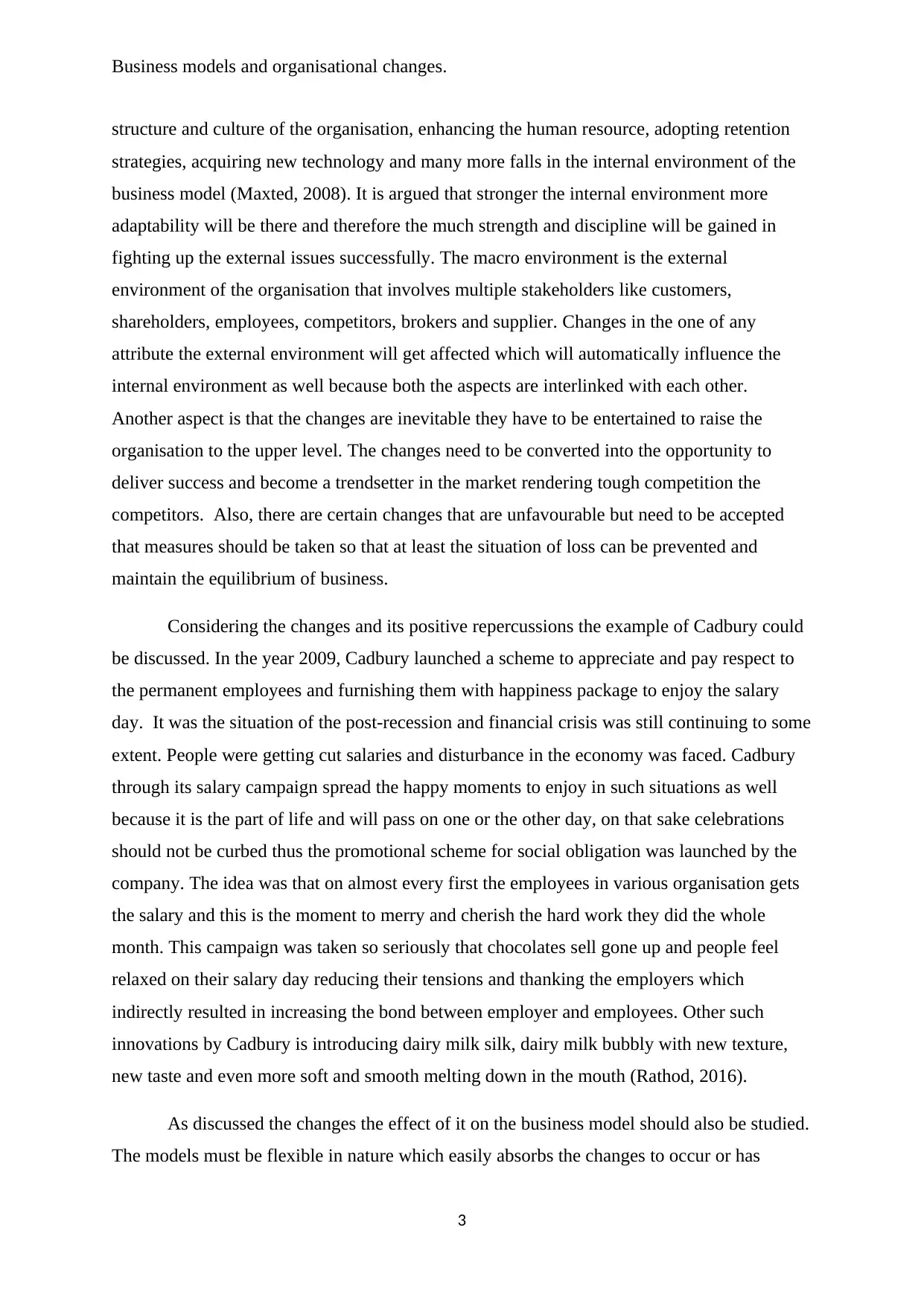
Business models and organisational changes.
structure and culture of the organisation, enhancing the human resource, adopting retention
strategies, acquiring new technology and many more falls in the internal environment of the
business model (Maxted, 2008). It is argued that stronger the internal environment more
adaptability will be there and therefore the much strength and discipline will be gained in
fighting up the external issues successfully. The macro environment is the external
environment of the organisation that involves multiple stakeholders like customers,
shareholders, employees, competitors, brokers and supplier. Changes in the one of any
attribute the external environment will get affected which will automatically influence the
internal environment as well because both the aspects are interlinked with each other.
Another aspect is that the changes are inevitable they have to be entertained to raise the
organisation to the upper level. The changes need to be converted into the opportunity to
deliver success and become a trendsetter in the market rendering tough competition the
competitors. Also, there are certain changes that are unfavourable but need to be accepted
that measures should be taken so that at least the situation of loss can be prevented and
maintain the equilibrium of business.
Considering the changes and its positive repercussions the example of Cadbury could
be discussed. In the year 2009, Cadbury launched a scheme to appreciate and pay respect to
the permanent employees and furnishing them with happiness package to enjoy the salary
day. It was the situation of the post-recession and financial crisis was still continuing to some
extent. People were getting cut salaries and disturbance in the economy was faced. Cadbury
through its salary campaign spread the happy moments to enjoy in such situations as well
because it is the part of life and will pass on one or the other day, on that sake celebrations
should not be curbed thus the promotional scheme for social obligation was launched by the
company. The idea was that on almost every first the employees in various organisation gets
the salary and this is the moment to merry and cherish the hard work they did the whole
month. This campaign was taken so seriously that chocolates sell gone up and people feel
relaxed on their salary day reducing their tensions and thanking the employers which
indirectly resulted in increasing the bond between employer and employees. Other such
innovations by Cadbury is introducing dairy milk silk, dairy milk bubbly with new texture,
new taste and even more soft and smooth melting down in the mouth (Rathod, 2016).
As discussed the changes the effect of it on the business model should also be studied.
The models must be flexible in nature which easily absorbs the changes to occur or has
3
structure and culture of the organisation, enhancing the human resource, adopting retention
strategies, acquiring new technology and many more falls in the internal environment of the
business model (Maxted, 2008). It is argued that stronger the internal environment more
adaptability will be there and therefore the much strength and discipline will be gained in
fighting up the external issues successfully. The macro environment is the external
environment of the organisation that involves multiple stakeholders like customers,
shareholders, employees, competitors, brokers and supplier. Changes in the one of any
attribute the external environment will get affected which will automatically influence the
internal environment as well because both the aspects are interlinked with each other.
Another aspect is that the changes are inevitable they have to be entertained to raise the
organisation to the upper level. The changes need to be converted into the opportunity to
deliver success and become a trendsetter in the market rendering tough competition the
competitors. Also, there are certain changes that are unfavourable but need to be accepted
that measures should be taken so that at least the situation of loss can be prevented and
maintain the equilibrium of business.
Considering the changes and its positive repercussions the example of Cadbury could
be discussed. In the year 2009, Cadbury launched a scheme to appreciate and pay respect to
the permanent employees and furnishing them with happiness package to enjoy the salary
day. It was the situation of the post-recession and financial crisis was still continuing to some
extent. People were getting cut salaries and disturbance in the economy was faced. Cadbury
through its salary campaign spread the happy moments to enjoy in such situations as well
because it is the part of life and will pass on one or the other day, on that sake celebrations
should not be curbed thus the promotional scheme for social obligation was launched by the
company. The idea was that on almost every first the employees in various organisation gets
the salary and this is the moment to merry and cherish the hard work they did the whole
month. This campaign was taken so seriously that chocolates sell gone up and people feel
relaxed on their salary day reducing their tensions and thanking the employers which
indirectly resulted in increasing the bond between employer and employees. Other such
innovations by Cadbury is introducing dairy milk silk, dairy milk bubbly with new texture,
new taste and even more soft and smooth melting down in the mouth (Rathod, 2016).
As discussed the changes the effect of it on the business model should also be studied.
The models must be flexible in nature which easily absorbs the changes to occur or has
3
Paraphrase This Document
Need a fresh take? Get an instant paraphrase of this document with our AI Paraphraser
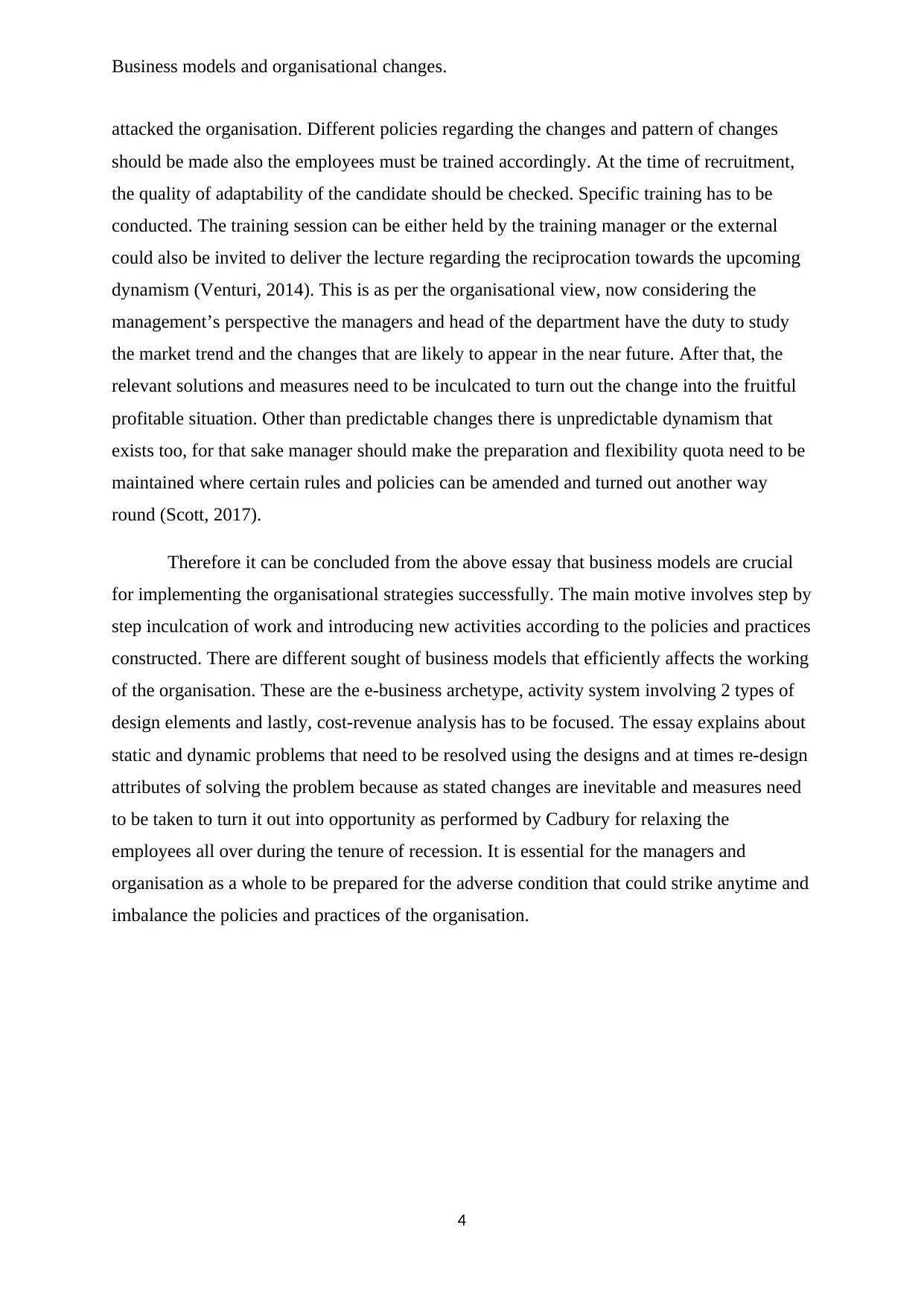
Business models and organisational changes.
attacked the organisation. Different policies regarding the changes and pattern of changes
should be made also the employees must be trained accordingly. At the time of recruitment,
the quality of adaptability of the candidate should be checked. Specific training has to be
conducted. The training session can be either held by the training manager or the external
could also be invited to deliver the lecture regarding the reciprocation towards the upcoming
dynamism (Venturi, 2014). This is as per the organisational view, now considering the
management’s perspective the managers and head of the department have the duty to study
the market trend and the changes that are likely to appear in the near future. After that, the
relevant solutions and measures need to be inculcated to turn out the change into the fruitful
profitable situation. Other than predictable changes there is unpredictable dynamism that
exists too, for that sake manager should make the preparation and flexibility quota need to be
maintained where certain rules and policies can be amended and turned out another way
round (Scott, 2017).
Therefore it can be concluded from the above essay that business models are crucial
for implementing the organisational strategies successfully. The main motive involves step by
step inculcation of work and introducing new activities according to the policies and practices
constructed. There are different sought of business models that efficiently affects the working
of the organisation. These are the e-business archetype, activity system involving 2 types of
design elements and lastly, cost-revenue analysis has to be focused. The essay explains about
static and dynamic problems that need to be resolved using the designs and at times re-design
attributes of solving the problem because as stated changes are inevitable and measures need
to be taken to turn it out into opportunity as performed by Cadbury for relaxing the
employees all over during the tenure of recession. It is essential for the managers and
organisation as a whole to be prepared for the adverse condition that could strike anytime and
imbalance the policies and practices of the organisation.
4
attacked the organisation. Different policies regarding the changes and pattern of changes
should be made also the employees must be trained accordingly. At the time of recruitment,
the quality of adaptability of the candidate should be checked. Specific training has to be
conducted. The training session can be either held by the training manager or the external
could also be invited to deliver the lecture regarding the reciprocation towards the upcoming
dynamism (Venturi, 2014). This is as per the organisational view, now considering the
management’s perspective the managers and head of the department have the duty to study
the market trend and the changes that are likely to appear in the near future. After that, the
relevant solutions and measures need to be inculcated to turn out the change into the fruitful
profitable situation. Other than predictable changes there is unpredictable dynamism that
exists too, for that sake manager should make the preparation and flexibility quota need to be
maintained where certain rules and policies can be amended and turned out another way
round (Scott, 2017).
Therefore it can be concluded from the above essay that business models are crucial
for implementing the organisational strategies successfully. The main motive involves step by
step inculcation of work and introducing new activities according to the policies and practices
constructed. There are different sought of business models that efficiently affects the working
of the organisation. These are the e-business archetype, activity system involving 2 types of
design elements and lastly, cost-revenue analysis has to be focused. The essay explains about
static and dynamic problems that need to be resolved using the designs and at times re-design
attributes of solving the problem because as stated changes are inevitable and measures need
to be taken to turn it out into opportunity as performed by Cadbury for relaxing the
employees all over during the tenure of recession. It is essential for the managers and
organisation as a whole to be prepared for the adverse condition that could strike anytime and
imbalance the policies and practices of the organisation.
4
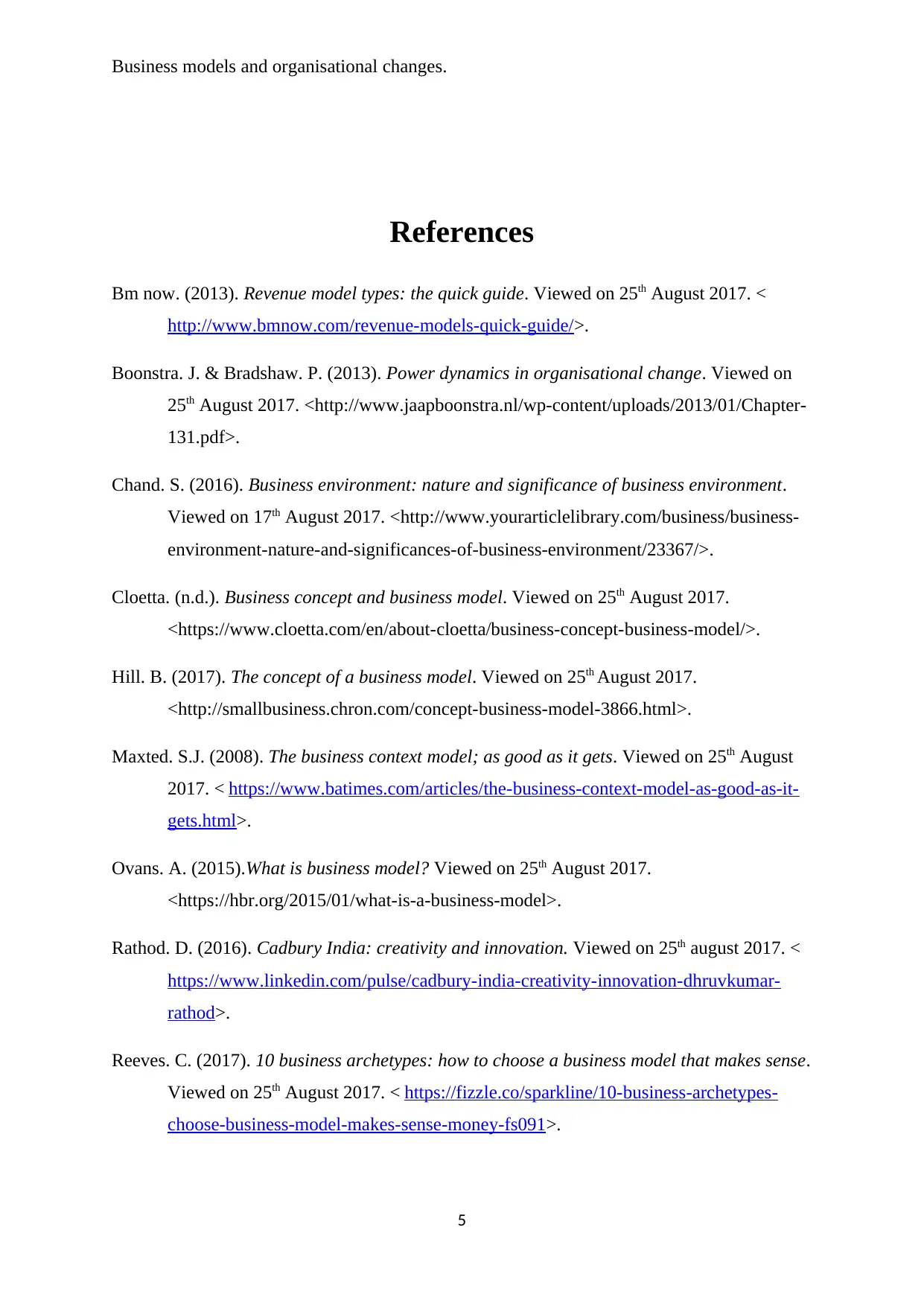
Business models and organisational changes.
References
Bm now. (2013). Revenue model types: the quick guide. Viewed on 25th August 2017. <
http://www.bmnow.com/revenue-models-quick-guide/>.
Boonstra. J. & Bradshaw. P. (2013). Power dynamics in organisational change. Viewed on
25th August 2017. <http://www.jaapboonstra.nl/wp-content/uploads/2013/01/Chapter-
131.pdf>.
Chand. S. (2016). Business environment: nature and significance of business environment.
Viewed on 17th August 2017. <http://www.yourarticlelibrary.com/business/business-
environment-nature-and-significances-of-business-environment/23367/>.
Cloetta. (n.d.). Business concept and business model. Viewed on 25th August 2017.
<https://www.cloetta.com/en/about-cloetta/business-concept-business-model/>.
Hill. B. (2017). The concept of a business model. Viewed on 25th August 2017.
<http://smallbusiness.chron.com/concept-business-model-3866.html>.
Maxted. S.J. (2008). The business context model; as good as it gets. Viewed on 25th August
2017. < https://www.batimes.com/articles/the-business-context-model-as-good-as-it-
gets.html>.
Ovans. A. (2015).What is business model? Viewed on 25th August 2017.
<https://hbr.org/2015/01/what-is-a-business-model>.
Rathod. D. (2016). Cadbury India: creativity and innovation. Viewed on 25th august 2017. <
https://www.linkedin.com/pulse/cadbury-india-creativity-innovation-dhruvkumar-
rathod>.
Reeves. C. (2017). 10 business archetypes: how to choose a business model that makes sense.
Viewed on 25th August 2017. < https://fizzle.co/sparkline/10-business-archetypes-
choose-business-model-makes-sense-money-fs091>.
5
References
Bm now. (2013). Revenue model types: the quick guide. Viewed on 25th August 2017. <
http://www.bmnow.com/revenue-models-quick-guide/>.
Boonstra. J. & Bradshaw. P. (2013). Power dynamics in organisational change. Viewed on
25th August 2017. <http://www.jaapboonstra.nl/wp-content/uploads/2013/01/Chapter-
131.pdf>.
Chand. S. (2016). Business environment: nature and significance of business environment.
Viewed on 17th August 2017. <http://www.yourarticlelibrary.com/business/business-
environment-nature-and-significances-of-business-environment/23367/>.
Cloetta. (n.d.). Business concept and business model. Viewed on 25th August 2017.
<https://www.cloetta.com/en/about-cloetta/business-concept-business-model/>.
Hill. B. (2017). The concept of a business model. Viewed on 25th August 2017.
<http://smallbusiness.chron.com/concept-business-model-3866.html>.
Maxted. S.J. (2008). The business context model; as good as it gets. Viewed on 25th August
2017. < https://www.batimes.com/articles/the-business-context-model-as-good-as-it-
gets.html>.
Ovans. A. (2015).What is business model? Viewed on 25th August 2017.
<https://hbr.org/2015/01/what-is-a-business-model>.
Rathod. D. (2016). Cadbury India: creativity and innovation. Viewed on 25th august 2017. <
https://www.linkedin.com/pulse/cadbury-india-creativity-innovation-dhruvkumar-
rathod>.
Reeves. C. (2017). 10 business archetypes: how to choose a business model that makes sense.
Viewed on 25th August 2017. < https://fizzle.co/sparkline/10-business-archetypes-
choose-business-model-makes-sense-money-fs091>.
5
⊘ This is a preview!⊘
Do you want full access?
Subscribe today to unlock all pages.

Trusted by 1+ million students worldwide
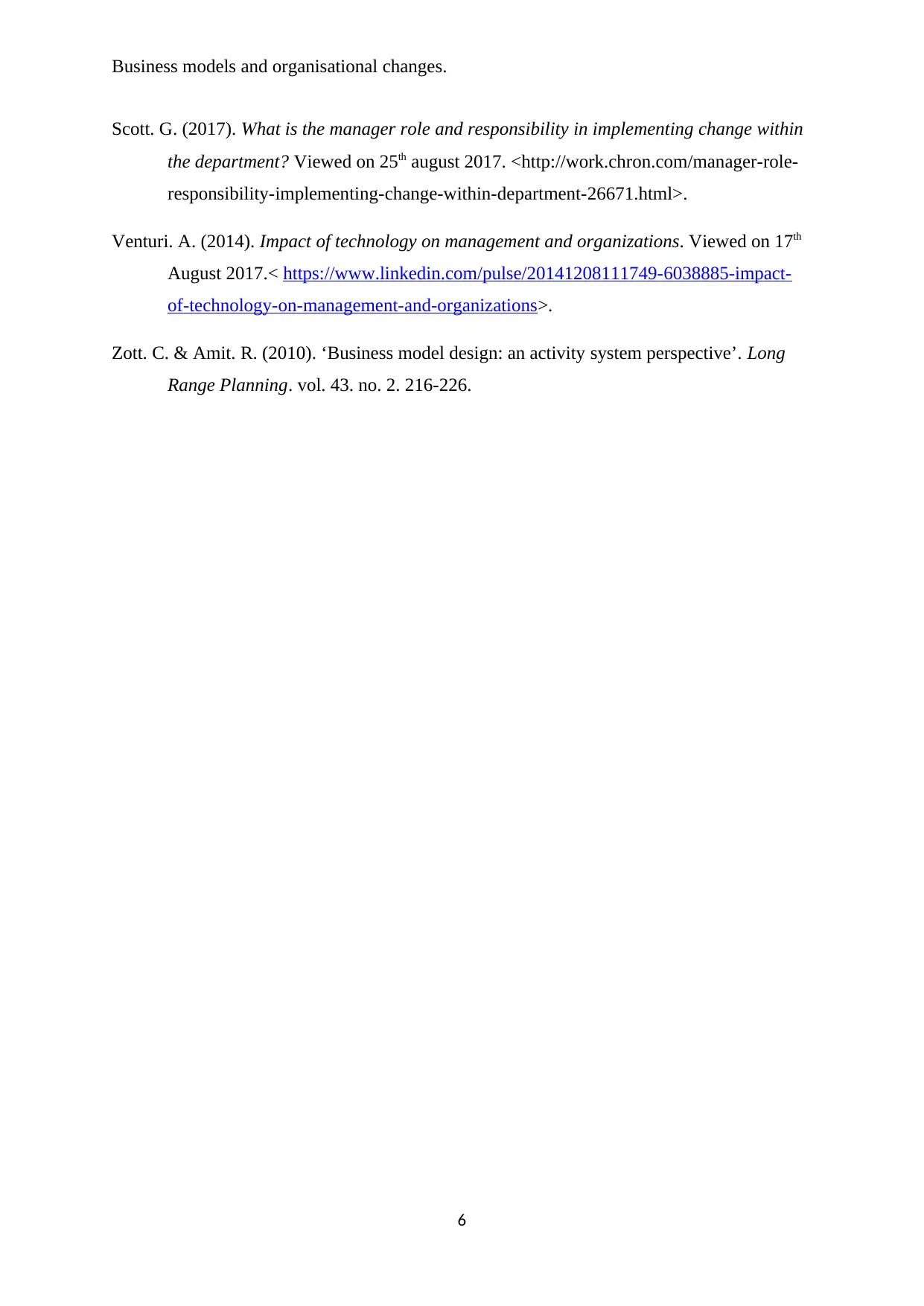
Business models and organisational changes.
Scott. G. (2017). What is the manager role and responsibility in implementing change within
the department? Viewed on 25th august 2017. <http://work.chron.com/manager-role-
responsibility-implementing-change-within-department-26671.html>.
Venturi. A. (2014). Impact of technology on management and organizations. Viewed on 17th
August 2017.< https://www.linkedin.com/pulse/20141208111749-6038885-impact-
of-technology-on-management-and-organizations>.
Zott. C. & Amit. R. (2010). ‘Business model design: an activity system perspective’. Long
Range Planning. vol. 43. no. 2. 216-226.
6
Scott. G. (2017). What is the manager role and responsibility in implementing change within
the department? Viewed on 25th august 2017. <http://work.chron.com/manager-role-
responsibility-implementing-change-within-department-26671.html>.
Venturi. A. (2014). Impact of technology on management and organizations. Viewed on 17th
August 2017.< https://www.linkedin.com/pulse/20141208111749-6038885-impact-
of-technology-on-management-and-organizations>.
Zott. C. & Amit. R. (2010). ‘Business model design: an activity system perspective’. Long
Range Planning. vol. 43. no. 2. 216-226.
6
1 out of 7
Related Documents
Your All-in-One AI-Powered Toolkit for Academic Success.
+13062052269
info@desklib.com
Available 24*7 on WhatsApp / Email
![[object Object]](/_next/static/media/star-bottom.7253800d.svg)
Unlock your academic potential
Copyright © 2020–2025 A2Z Services. All Rights Reserved. Developed and managed by ZUCOL.



